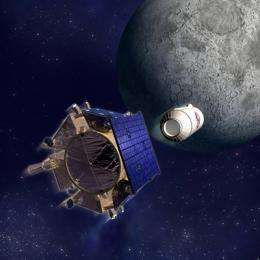The Lunar CRater Observation and Sensing Satellite, or LCROSS, will plunge into a crater near in the south polar region of the moon at 4:30 a.m. Arizona time Oct. 9. (Illustration: NASA)
(PhysOrg.com) -- Astronomers at the some of the best ground-based telescopes in southern Arizona plan to observe two lunar impacts at 4:30 a.m. and 4:34 a.m. Arizona time Friday.
Astronomers at the some of the best ground-based telescopes in southern Arizona plan to observe two lunar impacts at 4:30 a.m. and 4:34 a.m. Arizona time Friday, Oct. 9.
NASA is scheduled to fire a two-ton Centaur rocket, and four minutes later its shepherding spacecraft, into a crater at the moon’s south pole for the Lunar Crater Observation and Sensing Satellite mission, known as LCROSS, on Friday.
The LCROSS mission, which is piggybacking on NASA’s Lunar Reconnaissance Orbiter, is a search for water ice on the moon.
The rocket’s impact will create a debris plume that will rise about 6 miles above the lunar surface. Following four minutes behind, the shepherding spacecraft will fly through the debris plume, collect and relay data back to Earth before crashing into the lunar surface and creating a second debris plume.
The debris plumes are expected to be visible from Earth- and space-based telescopes 10-to-12 inches and larger.
Astronomers will use the powerful University of Arizona/Smithsonian Institution 6.5-meter MMTO telescope on Mount Hopkins, Ariz., in observations directed by MMTO director Faith Vilas.
NASA selected Vilas’ team from the MMTO and UA’s Steward Observatory as one of four teams to observe the impacts from Earth. NASA also funded telescopes in Hawaii and New Mexico to observe during LCROSS.
The 6.5-meter (21-foot) MMTO telescope “is well suited to address the first LCROSS mission science goal, which is to confirm the presence or absence of water ice in a permanently shadowed crater near a lunar polar region,” Vilas said.
Vilas’ team includes Philip Hinz of Steward Observatory. They’ll use the “CLIO” camera that Hinz developed to take images and spectra to monitor the shape and growth of the expanding plumes, as well as probe for evidence of “phyllosilicates,” or clays formed by the interaction of water with rocks.
“If we get the signature for phyllosilicates, then we’ve got a pretty firm indication that there’s been water there,” Vilas said.
“The CLIO camera is a good choice for these observations because we can get a very low-resolution spectrum - which is what we’re looking for in this case - across wavelengths between 2.5 microns and 4.5 microns,” she said.
The team prepared for LCROSS by taking some test observations at the telescope last month. But Vilas said there’s no guarantee that observers will see either the impact flash or plume. The weather could cloud them out. Or the flash and debris plume may not rise above mounds at the lip of the deep crater that somewhat block the MMT’s view.
David Harvey of Steward Observatory is ready to observe LCROSS impact with the 1.8-meter (71-inch) Vatican Advanced Technology Telescope on Mount Graham near Safford, Ariz., using a different filter that complements the MMTO observations.
“We’re looking in the visual, with a v-band filter, to get a two-dimensional structure of the plume that the MMT team can use to help interpret their data,” Harvey said. The VATT data will also help astronomers get a better look at water information in the MMT data.
Like the MMT, the Vatican telescope did a trial run in early September. But VATT observers were plagued by weather problems, and that may be the case early Friday, Harvey said.
“We’re having some unusual weather,” Harvey said on Tuesday. “Right now we’re actually sitting inside the clouds on Mount Graham, and it’s supposed to snow on Thursday. The forecast does not look good.”
Astronomers on other UA telescopes, including the 24-inch SkyCenter telescope and the 60-inch telescope on Mount Lemmon in the Santa Catalina Mountains north of Tucson, say they plan to take images or video as well, more for documentary than scientific purposes.
NASA has scheduled a pre-impact media teleconference Oct. 8, at 11:30 a.m. PDT (2:30 p.m. EDT). To hear live audio of the teleconference, which will be streamed online, click here.
NASA TV will broadcast live coverage of the LCROSS impacts with expert commentary 3:30 a.m. to 7 a.m. PDT on Friday, Oct. 9, and also broadcast a post-impact news conference a few hours after impact.
More information: Click here for the latest information about the live LCROSS Impact Broadcast on NASA TV.
Provided by University of Arizona (news : web)























